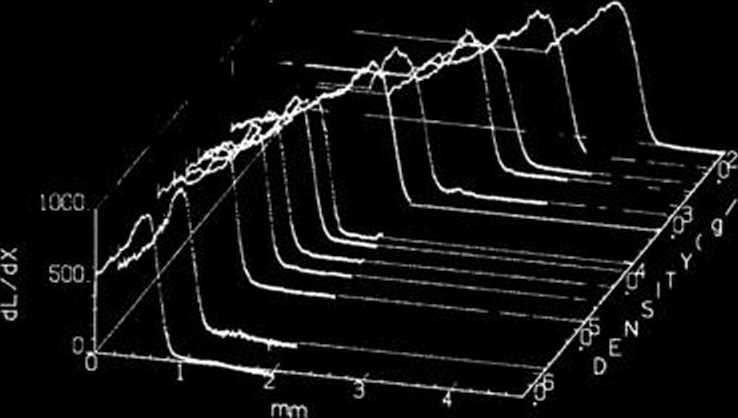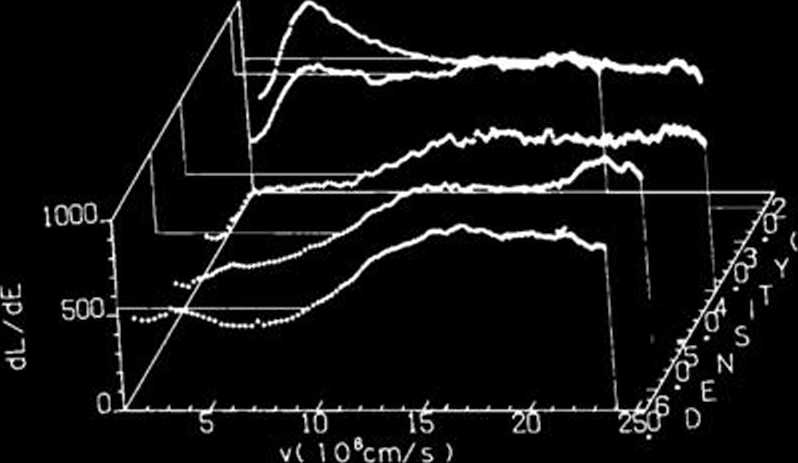372596252
88
RIKEN Accel Próg. Rep. 24 (1990)
111-4. Radiation Chemistry and Radiation Biology
1. High-Density Excitation by Heavy lons: Track-Depth Resolved Luminescence of N-ions Injected-Helium Gas and Liquid
K. Kimura, J. Wada, and M. Arai
lons of few MeV/amu show characteristic radiation effects such as charge exchange, wake field, and convoy electrons. Furthermore, in their tracks, electronic excited States are contained at an extremely high density. Our studies aim to find characteristic phenomena caused by above effects and elucidate them. For these purposes, space- and time-resolved luminescence measurements were done.
A space-resolved or track-depth resolved luminescence were measured using a following eąuip-ment named a tack scope. The track scope was composed of a ąuartz imaging fiber and a position detective photon-counter. One end of the fiber was mounted in a cryostat and thereby temperaturę and pressure of sample helium were adjusted. The image projected from the other end, namely, luminescence intensities along the path of ion tracks, was digitized by a position-detective photon-counter. (See Ref. 1.) Also, depth-resolved luminescence spectra were measured by the change of a section of the fuli image which enters into a monochromator through a monochromator-slit.
Figurę 1 shows helium-density dependent specific luminescence, dL/dx, as a function of track-

WAVELENGTH/A
Fig. 2. Depth-resolved and density-dependent luminescence spectra.
second peak was observed at the Iow energy side.
The positions of the first peaks were invariant with variation in the helium density. These peaking were explained by the effect of excitation density. On the other hand, the positions of the second ones varied with variation in the helium density and excitation density, but they appeared at a given ionic velocity with variation of helium density as shown in Fig. 3. The second peaking may be attributable to charge exchanges or direct excitations.
I

Fig. 1. Specific luminescence, dL/dx, vs. the depth of N-ion tracks and its helium density dependence. AU the curves are illustrated in equiheight.

Fig. 3. Luminescence efficienty, dL/dE, vs. ionic velocity and its helium density dependence. Ali the curves are illustrated in eguiheight.
References
1) K. Kimura: Nuci. lustrum. Methods B, in press.
depth. Luminescence spectra were changed scarcely except for their intensities; peaks were assigned to be due to the d-b, D-B, H-C, and J-C transitions between excimer States (Fig. 2). The most important finding is a splitting of Bragg-like curve of dUdE vs. excitation density. Namely, the first peak positioned at the high energy side of the maximum stopping power and in addition to it the
Wyszukiwarka
Podobne podstrony:
92 RIKEN Accel. Próg. Rep. 24 (1990)111-5. Instrumentation1. Design of a Microbeamline for a Compact
94 RIKEN Accel. Próg. Rep. 24 (1990)111-5-2. Design of a Decay Muon Channel Using an Axially Symmetr
102 RIKEN Accel Próg. Rep. 24 (1990)111-5-8. Performance of Isotopic Separation in RIPS T.Nakamura,
103 RIKEN Accel. Próg. Rep. 24 (1990)111-5-9. Test Experiment of the GARIS/IGISOL K. Morita, T. Nomu
105 RIKEN Accel. Próg. Rep. 24 (1990)111-5-10. Velocity Distribution of IGISOL lon Beams M. Koizumi,
108 RIKEN Accel. Próg. Rep. 24 (1990)111-5-12. Status Report of the RIKEN Swinger-Magnetic Analyzer
110 RIKEN Accel. Próg. Rep. 24 (1990)111-5-14. Test for Dispersive-Mode Beam Transportto the SMART
116 RIKEN Accel. Próg. Rep. 24 (1990)111-5-19. Responses of Large Position-Sensitive Detectorsto Hea
RIKEN Accel. Próg. Rep. 24 (1990)111-5-25. High Speed Serial Data Link for PC-9801 J. Fujita > PC
11 RIKEN Accel. Próg. Rep. 24 (1990)111-1-2. Three a Disintegration of 12C in the Field of208Pb Nucl
12 RIKEN Accel. Próg. Rep. 24 (1990)111-1-3. Coulomb Breakup Reaction of 90 MeV/u 140 T. Takei, T. M
29 RIKEN Accel. Próg. Rep. 24 (1990)111-1-19. Dissociation Cross Sections of nLiK. Soutome, S. Yamaj
RIKEN Accel. Próg. Rep. 24 (1990)111-1-20. Induced Fission Studied with a Multi-DimensionalLangevin
48 RIKEN Accel. Próg. Rep. 24 (1990)111-2-15. High Resolution L X-Ray Angular Distribution Measureme
56 RIKEN Accel. Próg. Rep. 24 (1990)111-2-22. Electron Spectra from Doubly Excited Boroń lonsProduce
63 RIKEN Accel. Próg. Rep. 24 (1990)111-2-28. Development of Nuclear Track Microfilters N. Nakanishi
72 RIKEN Accel. Próg. Rep. 24 (1990)111*3-8. Dry Separation of Radioactive Nuclides from a Gold Targ
74 RIKEN Accel. Próg. Rep. 24 (1990)111*3-10. A Multitracer Study of the Adsorption of Metal Element
więcej podobnych podstron